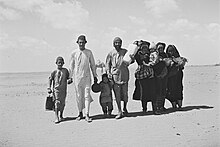This article has multiple issues. Please help improve it or discuss these issues on the talk page. (Learn how and when to remove these messages)
|

| Part of a series on |
| Jewish exodus from the Muslim world |
|---|
 |
| Background |
| Antisemitism in the Arab world |
| Exodus by country |
| Remembrance |
| Related topics |
| Part of a series on |
| Aliyah |
|---|
 |
| Concepts |
| Pre-Modern Aliyah |
| Aliyah in modern times |
| Absorption |
| Organizations |
| Related topics |
The migration of Moroccan Jews to Israel has been made all over the centuries. Moroccan Jews in Israel have been the founders of many pioneer neighborhoods in Jerusalem (Mahane Israel in 1867), Tel Aviv, Haifa, Tiberias and others.
Following World War II, especially after the establishment of Israel, Moroccan Jewish communities, which were the largest among Jewish communities in North Africa at the time,[1] faced significant challenges. Pogroms in Oujda and Jerada, coupled with concerns that Morocco's eventual independence from France might result in the persecution of the country's Jewish population, prompted a substantial wave of emigration. Between 1948 and 1951, approximately 28,000 Jews made Aliyah to Israel.[2]
With the return of Mohammed V and the subsequent declaration of Morocco's independence in 1956, Jewish residents were granted Moroccan citizenship. These differences included travel restrictions abroad. In 1959, due to pressure from the Arab League, Jewish emigration was officially prohibited if the intended destination was Israel. As a result, most immigration occurred clandestinely through an underground Jewish organization in Morocco, with routes often passing through Spain and France.
Between 1961 and 1964, Operation Yachin saw Mossad and HIAS strike a clandestine agreement with King Hassan II to covertly facilitate the migration of Moroccan Jews to Israel. During this three-year span, Moroccan Jewish immigration to Israel reached its zenith, with 97,000 individuals departing for Israel via both air and sea routes from Casablanca and Tangier, transiting through France and Italy. As part of this migration, Morocco received "indemnities" in compensation for the loss of its Jewish population.[3]
By 1967, approximately 250,000 Jews had left Morocco, with some seeking refuge in Europe and the United States, while a significant portion chose to immigrate to Israel. All in all, 274,180 individuals are recorded to have emigrated from Morocco to Israel between the establishment of the state in 1948 and 2016.[4] Moroccan Jewish immigrants in Israel faced numerous challenges related to cross-cultural adaptation and integration, which eventually became defining aspects of this immigration wave. The cultural barriers and discrimination they encountered prompted protests (such as the Wadi Salib riots) and, over time, contributed to a gradual transformation in the Israeli political landscape.
- ^ "Return to Morocco". www.aljazeera.com. Archived from the original on 2017-09-24. Retrieved 2017-05-20.
- ^ "IMMIGRANTS, BY PERIOD OF IMMIGRATION, COUNTRY OF BIRTH AND LAST COUNTRY OF RESIDENCE" (PDF). CBS, Statistical Abstract of Israel. Government of Israel. 2009.
- ^ "The Jews of the Middle East and North Africa in modern times", by Reeva S. Simon, Michael M. Laskier, Sara Reguer, p.502.
- ^ "נתון אחד ביום: רוב יהודי מרוקו חיים בישראל". Davar. April 2021. Retrieved 6 December 2022.